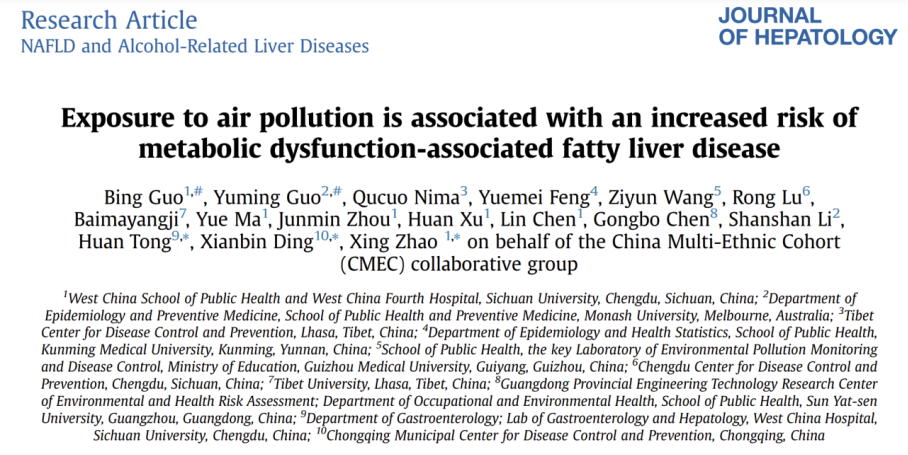The China Multi-Ethnic Cohort collaborative group of West China School of Public Health published in Journal of Hepatology its result findings “Exposure to air pollution is associated with an increased risk of metabolic dysfunction-associated fatty liver disease” on Dec. 6th 2021. This study provides evidence that long-term exposure to air pollution was significantly associated with increased odds of metabolic dysfunction-associated fatty liver disease (MAFLD).
According to China Multi-Ethnic Cohort study (CMEC), over the last few decades, non-alcoholic fatty liver disease (NAFLD) has been considered a hepatic feature of a systemic metabolic disorder and was recently renamed metabolic dysfunction-associated fatty liver disease (MAFLD). As a heterogeneous disease, MAFLD may progress to end stage liver diseases (e.g., cirrhosis and liver cancer), liver transplantation, and even liver-related death. The prevalence of MAFLD is approximately 25% worldwide and has significantly increased in Asia (from 25.28% during 1999–2005 to 33.90% during 2012 -2017). Clearly, MAFLD is a growing global health challenge and poses a substantial economic burden to all societies.
The MAFLD epidemic corresponds to environmental and lifestyle changes that have occurred alongside rapid industrialization worldwide, especially in many Asian countries. A pollution (AP), which is the biggest environmental problem caused by industrialization, may increase the risk of metabolic disorders (such as insulin resistance and dyslipidemia) and related diseases (such as type 2 diabetes mellitus and metabolic syndrome) in populations. Animal experiments have further provided mechanistic plausibility that breathing air pollutants increases the risk of MAFLD, the disease related to metabolic disorders. Specifically, fine particulate matter exposure may trigger a non-alcoholic steatohepatitis (NASH)-like phenotype, impair hepatic glucose metabolism and promote hepatic fibro-genesis. Multi-omics analysis also found that co-exposure to phthalates and metals, the components of particulate matter, disturbs biochemical processes.

For this study, the Journal of Hepatology also invited Prof. Massimo Colombo of San Raffaele hospital in Italy (Chairman of EASL International Liver Foundation; former editor in chief of the Journal of Hepatology ) and Prof. Robert Barouki of the University of Paris to write simultaneous review articles. The review article believes that the study of liver exposure omics is expected to strengthen the prevention and treatment of MAFLD. This study provides new epidemiological evidence for the hypothesis that air pollution triggers MAFLD as well as its course, and reflects the ever-expanding liver exposome and its impacts on liver biology and disease.
SCU’s West China School of Public Health (West China Fourth Hospital) is the first work unit of this paper. The first authors are Bing Guo, an assistant researcher of West China School of Public Health and Yuming Guo, professor of the School of Public Health and Preventive Medicine, Monash University. Xing Zhao of West China School of Public Health (West China Fourth Hospital), Xianbin Ding of Chongqing Municipal Center for Disease Control and Prevention, and Huan Tong of the Department of Gastroenterology, West China Hospital are the co corresponding authors. Prof. Xiaosong Li of West China School of Public Health provided leadership and made fundamental contribution to the establishment of the CMEC. This work was supported by the National Key Research and Development Program of China (Grant No. 2017YFC0907305). This work was also supported by the National Natural Science Foundation of China (Grant No. 81973151, 81773548) and China Postdoctoral Science Foundation (Grant No. 2020M683335).
https://doi.org/10.1016/j.jhep.2021.10.016
https://doi.org/10.1016/j.jhep.2021.11.001
